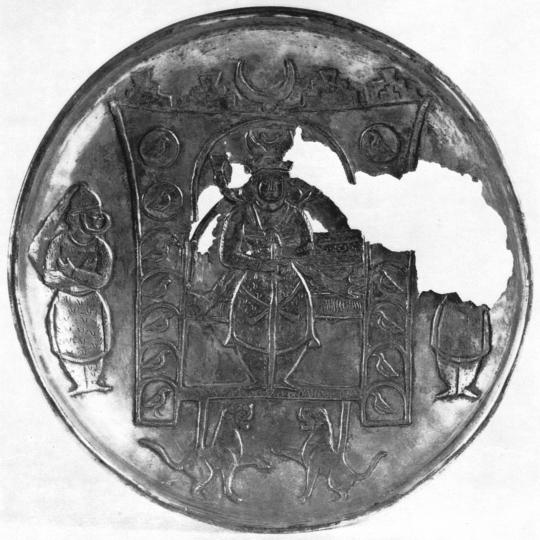Try Amazon Fresh

Try Amazon Fresh
'Qazvin Enthronement Plate'
Silver plate from the vicinity of Qazvin. Iran Bastan Museum, Tehran.

A larger image of the 'Qazvin Enthronement Plate'. Silver plate from the vicinity of Qazvin. Iran Bastan Museum, Tehran.
Plate IVa Thrones and Enthronement Scenes in Sasanian Art by P. O. Harper
p 50, "The three remaining silver vessels with "Sasanian" scenes of enthronement are, as will be explained below, almost certainly Islamic in date.
One, from Klimova, in the Perm, has an illustration of a banqueting couch throne (Pl. I).5
The figure seated upon it wears no form of royal headdress at all.
The two other vessels in the Tehran Museum (Pl. IVa)6 and in the Walters Art Gallery (Pl. V)7
show persons whose crowns resemble but do not closely imitate Sasanian royal headdresses. On the evidence of these five vessels,
all of which have figures seated upright on banqueting couches, it has been assumed that this was the standard Sasanian throne type.
No examination has been made of the early Sasanian rock reliefs (Pls. VI, VIIa) with enthroned kings nor of the Sasanian coins (Pl. IVb),
where an entirely different throne appears. It is with this first type that a discussion of the Sasanian throne must begin."
Source: Thrones and Enthronement Scenes in Sasanian Art by P. O. Harper.
On the Qazvin plate the actual throne seat, a banqueting couch, is a minor element placed in the background behind the king, who is not seated upon it (Pl. 34).77 The legs of the throne are either hidden or incorporated into the structure of the arch. Only the long bench with five cushions piled up on the king's left appears. The throne building is topped by stepped crenelations and a central crescent, features that have suggested a comparison between this structure and the arched rock-cut niche usually attributed to Khusro II at Taq-i Bustan. A somewhat closer parallel is the newly reconstructed monument at Taq-i Girra, where the sides of the crenelations slant obliquely inward as on the silver plate.78 This feature is, in general, more typical of Islamic monuments than those of Sasanian date. On the Qazvin plate the whole throne rests on two lions.79 Completely unknown on objects belonging to the Sasanian period is the garment worn by the king and his attendants and the absence of a star or globe within the crescent on the royal crown. The fillets, falling below the king's waist, end in three points decorated with circular jewels.80 This is a detail that is repeated on an eighth-century painting at Qasr al-Hayr West81 but rarely occurs on Sasanian monuments.82 The sharp upward slant of the wings rising from the king's crown and their straight outline are features that characterize the
wings on the crowns of the ninth-century Abbasid governors of Tabaristan.83 On Arab-Sasanian coins the position of the king's hands as they grasp the sword is often the opposite of that on Sasanian objects, where the right hand rests on the pommel and the left grasps the hilt.84 The hands are also reversed on the Qazvin plate. The headgear of the attendant standing to the left of the throne on the silver plate is worthy of comment, as it, too, is unique.85 A band passing before the mouth, drawn up to the top of the head and tied so that the ends fall down behind, appears on other Iranian works of art. This covering of the mouth in deference to an exalted presence was a well-known tradition at the Sasanian court.86 On the Qazvin plate a ribbon is attached to the top of the cap but is not visibly connected in any way to the mouth band. A few unusual Arab-Sasanian coins of the late seventh century show the caliph wearing a curved cap having a fillet projecting from the top.87 Above this is a typical Sasanian globe, a major variation from the headgear on the silver plate. It appears that the form and function of the mouthband were no longer understood on the vessel, and that it is consequently portrayed incorrectly.
The Qazvin plate is distinguished from other royal Sasanian silver vessels not only in the details of the iconography but also in the drapery style. Although there are a few short paired lines on the drapery, they are a minor feature. Instead, U-shaped patterns cover the clothing, an exaggerated stylization of late Sasanian drapery folds.
On the basis of this evidence it is not likely that the Qazvin plate is a Sasanian work. Since it was found in Iran, and there is nothing in the iconography, style, or method of manufacture to suggest foreign workmanship, one must suppose that it postdates the Sasanian era. No sample of the silver was available for analysis. The details noted above suggest that the plate may have been made in the century and a half following the collapse of the Sasanian dynasty, but no close parallels exist for its general appearance.
Source: pp.116-117, Harper, Prudence and Meyers, Pieter Silver Vessels of the Sasanian Period. Volume One: Royal Imagery, The Metropolitan Museum of Art, Princeton University Press, New York, 1981
Back to Sasanian and Central Asian Plates


